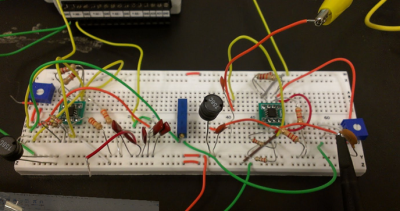Group 3 2012
Chaos Circuits
Patrick Chang, Edward Coyle, John Parker, Majid Sodagar
Introduction
Chaos is aperiodic long-term behavior in a deterministic system that exhibits sensitive dependence on initial conditions. Chaotic signals are usually broadband, noise like, and difficult to predict. Therefore chaotic systems are suitable to carry information. In digital communication, sinusoidal carriers are used because they have optimal bandwidth efficiency and a relative ease of reconstruction of the original signal. However, their high power spectral density would cause a high level of interference and enhance the probability of interception by other receivers. Chaotic carrier can solve this problem. A chaotic transmitter can send chaotic signal to the receiver, which synchronizes with the transmitter. Once synchronization is achieved, messages can be hidden in the chaotic signal and therefore be protected from unwanted interceptions. Also, broadband information carriers enhance the robustness of communication and are less vulnerable to interference from narrow-band disturbance. This is the basis of spread-spectrum communication techniques, such as the code division multiple access (CDMA) protocol used in the Global Positioning System (GPS) and in the third generation of mobile telephones.
Design and Parts
Chua's Circuit
Parts
- 3 - 10 nF Capacitors
- 3 – 100 nF Capacitors
- 3 – 15 mH Inductors
- 3 – Variable Resistors in kΩ range
- 6 – 220 Ω Resistors
- 6 – 22 kΩ Resistors
- 3 – 2.2 kΩ Resistors
- 3 – 3.3 kΩ Resistors
- 6 – MA23L3 Ultrasonic Transducers
- 3 – TL082
Procedure
References
Websites
[1] http://crossgroup.caltech.edu/chaos_new/Chua.html [2] http://www.wellgainelectronics.com/muratama23l3.aspx [3] http://www.chuacircuits.com/ [4] http://www.chuacircuits.com/sim.php [5] http://nonlinear.eecs.berkeley.edu/chaos/chaos.html
Literature
[6] S. H. Strogatz, Nonlinear Dynamics and Chaos: With Applications To Physics, Biology, Chemistry, And Engineering (Studies in Nonlinearity). Westview Press, 2001, p. 512.
[7] K. Cuomo, “Synchronization of Lorenz-based chaotic circuits with applications to communications,” Circuits and systems II: …, vol. 40, no. 10, pp. 626–633, 1993.
[8] P. Arena, A. Buscarino, L. Fortuna, and M. Frasca, “Separation and synchronization of piecewise linear chaotic systems,” Physical Review E, vol. 74, no. 2, pp. 1–11, Aug. 2006.
[9] A. Argyris, D. Syvridis, L. Larger, V. Annovazzi-Lodi, P. Colet, I. Fischer, J. García-Ojalvo, C. R. Mirasso, L. Pesquera, and K. A. Shore, “Chaos-based communications at high bit rates using commercial fibre-optic links.,” Nature, vol. 438, no. 7066, pp. 343–6, Nov. 2005.
[10] Y. Harada, K. Masuda, and A. Ogawa, “Dynamical behavior of acoustically coupled chaos oscillators,” Fractals-an Interdisciplinary …, 1996.
